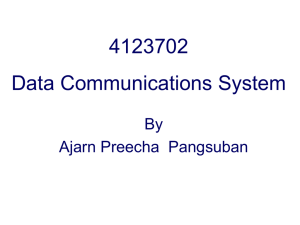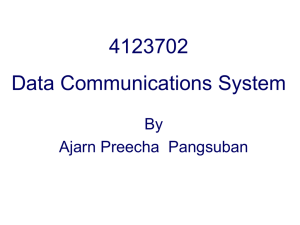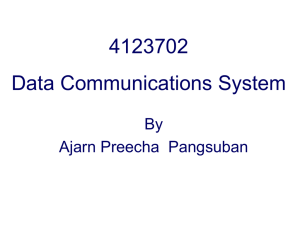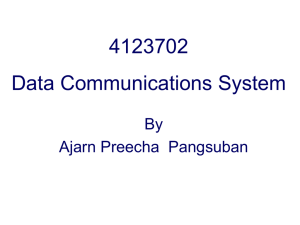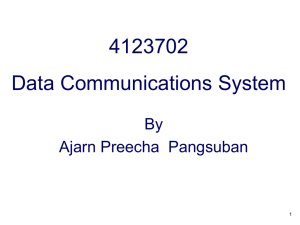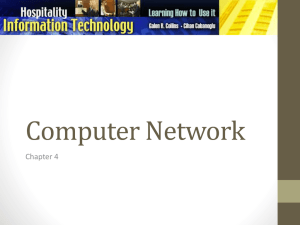CIS 321 Data Communications & Networking
advertisement
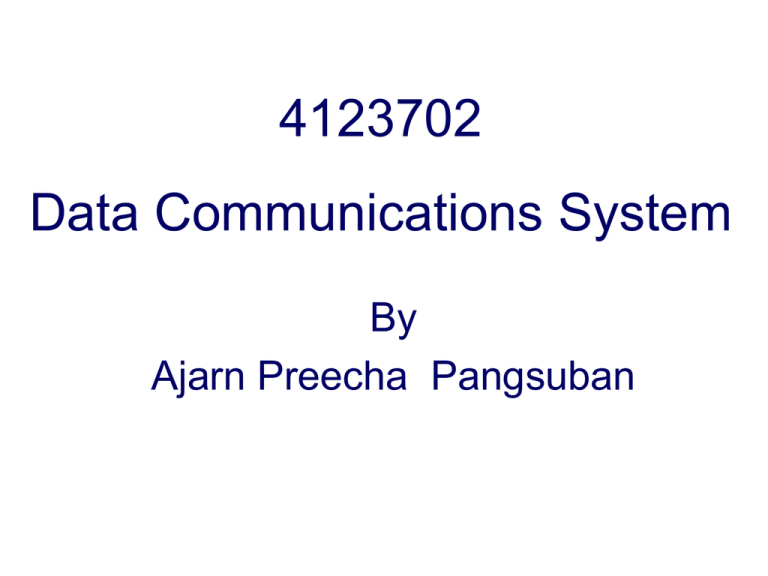
4123702 Data Communications System By Ajarn Preecha Pangsuban Chapter 7 – Transmission Media Relation to Internet Model Actually located below the physical layer Directly controlled by the physical layer 4123702 Data Communications System @YRU 3 Introduction Data must be converted into electromagnetic signals to be transmitted from device to device Signals can travel through a vacuum, air, or other media May be in the form of power, voice, radio waves, infrared light, and X, gamma, and cosmic rays Each of these forms constitutes a portion of the electromagnetic spectrum 4123702 Data Communications System @YRU 4 Electromagnetic Spectrum 4123702 Data Communications System @YRU 5 Categories of Media Guided Media Twisted pair, coaxial, and fiber-optic Unguided Media Radio waves, infrared light, visible light, and X, gamma, and cosmic rays Sent by microwave, satellite, and cellular transmission 4123702 Data Communications System @YRU 6 Guided Media Twisted-pair and coaxial use copper conductors to accept and transport signals in form of electrical current Optical fiber is glass or plastic cable that accepts and transports signals in form of light 4123702 Data Communications System @YRU 7 Twisted-Pair Cable Two conductors surrounded by insulating material One wire used to carry signals; other used as a ground reference Twisting wires reduces the effect of noise interference or crosstalk since both wires will likely be equally affected More twists = better quality 4123702 Data Communications System @YRU 8 Effect of noise on parallel line 16 Effect of noise on parallel line 4123702 Data Communications System @YRU 9 Effect of noise on twisted-pair lines 4123702 Data Communications System @YRU 10 Unshielded Twisted Pair (UTP) Most common type; suitable for both voice and data transmission Frequency range is from 100 Hz to 5 MHz Categories are determined by cable quality Cat 3 commonly used for telephone systems (up to 10 Mbps) Cat 5e usually used for data networks (up to 100 Mbps) Performance is measured by attenuation versus frequency and distance 4123702 Data Communications System @YRU 11 UTP example 4123702 Data Communications System @YRU 12 UTP (cont) Adv: cheaper, flexible, easy to install UTP connectors attach to wire; most commonly used is RJ45, which have 8 conductors, one for each of four twisted pairs 4123702 Data Communications System @YRU 13 Shielded Twisted Pair (STP) By IBM A metal foil or braided-mesh covering encases each pair of insulated conductors to prevent electromagnetic noise called crosstalk Uses same connectors More expensive but less susceptible to noise 4123702 Data Communications System @YRU 14 STP example 4123702 Data Communications System @YRU 15 Categories of unshielded twisted-pair cables Category Max Speed Digital/Analog Use 1 < 100 kbps Analog Telephone 2 2 Mbps Analog/digital T-1 lines 3 10 Mbps Digital LANs 4 16 Mbps Digital LANs 5e 1 Gbps Digital LANs 6 1 Gbps Digital LANs 7 (Draft) 10 Gbps Digital LANs 4123702 Data Communications System @YRU 16 Color code for 4 cable pairs Pair # 1 2 3 4 Primary color Secondary color (stripe) Blue White Orange White Green Brown 4123702 Data Communications System @YRU White White 17 UTP connector 4123702 Data Communications System @YRU 18 The T568A and T568B wiring patterns T568A Jack 1 2 3 4 5 6 7 8 W/G G W/O B W/B O W/Br Br Pair 3 Pair 1 Pair 2 Pair 4 8-pin modular jack (front view) 4123702 Data Communications System @YRU T568B Jack 1 2 3 4 5 6 7 8 W/O O W/G B W/B G W/Br Br Pair2 Pair 1 Pair 3 Pair 4 8-pin modular jack (front view) 19 UTP performance 4123702 Data Communications System @YRU 20 Coaxial Cable Has a central core conductor enclosed in an insulating sheath, encased in an outer conductor of metal foil Frequency range is between 100 KHz and 500 MHz RG numbers denote physical specs such as wire gauge thickness and type of insulator construction of shield size/type of outer casing 4123702 Data Communications System @YRU 21 RG numbers RG-8, RG-9, and RG-11 used in thick Ethernet (50) RG-58 used in thin Ethernet (50) RG-59 used for TV (75) 4123702 Data Communications System @YRU 22 Coaxial Cable example 4123702 Data Communications System @YRU 23 Coaxial Cable Connectors Most common is barrel connector (BNC) T-connectors are used to branch off to secondary cables Terminators are required for bus topologies to prevent echoing of signals 4123702 Data Communications System @YRU 24 Coaxial Performance Higher bandwidth than twisted-pair However, attenuation is higher and requires frequent use of repeaters 4123702 Data Communications System @YRU 25 Coaxial Applications Analog telephone networks , single coaxial network could carry 10,000 voice signals Digital telephone networks , single coaxial network could carry digital data up to 600 Mbps Cable TV networks Traditional Ethernet LANs 4123702 Data Communications System @YRU 26 Coaxial cable performance 4123702 Data Communications System @YRU 27 Fiber-Optic Cable Made of glass or plastic; signals are transmitted as light pulses from an LED or laser Speed depends on density of medium it is traveling through; fastest when in a vacuum, 186,000 miles/second 4123702 Data Communications System @YRU 28 Refraction 4123702 Data Communications System @YRU 29 Critical Angle 4123702 Data Communications System @YRU 30 Reflection 4123702 Data Communications System @YRU 31 Fiber Construction (1) 4123702 Data Communications System @YRU 32 Fiber Construction (2) 4123702 Data Communications System @YRU 33 Propagation Modes Method for transmitting optical signals: Multimode Multimode step-index fiber Multimode graded-index fiber Single Mode 4123702 Data Communications System @YRU 34 Propagation Modes (cont) 4123702 Data Communications System @YRU 35 Multimode Multiple beams from light source move through core at different paths Multimode step-index fiber Index refers to the index of refraction Density remains constant from center to edges Light moves in a straight line until it reaches the cladding Some beams penetrate the cladding and are lost, while others are reflected down the channel to the destination 4123702 Data Communications System @YRU 36 Multimode (cont) As a result, beams reach the destination at different times and the signal may not be the same as that which was transmitted Multimode graded-index fiber May be used to decrease this problem and to allow for more precise transmissions Graded-index refers to varying densities of the fiber; highest at center and decreases at edge 4123702 Data Communications System @YRU 37 Multimode (cont) Since the core density decreases with distance from the center, the light beams refract into a curve Eliminates problem with some of the signals penetrating the cladding and being lost 4123702 Data Communications System @YRU 38 Single Mode Only one beam from a light source is transmitted using a smaller range of angles Smaller diameter Makes propagation of beams almost horizontal; delays are negligible All beams arrive together and can be recombined without signal distortion 4123702 Data Communications System @YRU 39 Light Sources Light source is light-emitting diode (LED) or a laser LEDs are cheaper but not as precise (unfocused); limited to short-distance use Lasers can have a narrow range, better control over angle Receiving device needs a photosensitive cell (photodiode) capable of receiving the signal 4123702 Data Communications System @YRU 40 Fiber types Size Core Cladding Mode 50/125 50 125 Multimode, graded-index 62.5/125 62.5 125 Multimode, graded-index 100/125 100 125 Multimode, graded-index 7 125 Single-mode 7/125 4123702 Data Communications System @YRU 41 Fiber Sizes Single mode 7/125 Multimode 50/125 4123702 Data Communications System @YRU Multimode 62.5/125 Multimode 100/125 42 Packing methods for fiber cable 4123702 Data Communications System @YRU 43 Fiber-Optic cable connectors (1) Subscriber Channel (SC) Connection It uses Push/pull locking system mechanism Used in cable TV Straight-tip (ST) Connection It uses a bayonet locking system Used for connecting cable to networking devices More reliable than SC MT-RJ New connector with the same as RJ45 4123702 Data Communications System @YRU 44 Fiber-Optic cable connectors (2) 4123702 Data Communications System @YRU 45 Optical fiber performance 4123702 Data Communications System @YRU 46 Applications of Fiber Optics Backbone networks due to wide bandwidth and cost effectiveness Up to 1600 Gbps with WDM (Synchronous Optical Network : SONET) Cable TV LANS 100Base-FX (Fast Ethernet) 1000Base-X 4123702 Data Communications System @YRU 47 Advantages of Fiber Optics Higher bandwidth than twisted-pair and coaxial cable; not limited by medium, but by equipment used to generate and receive signals Noise resistance Less signal attenuation Immunity to EMI More resistant to corrosive materials Lightweight Greater security (More immune to tapping) 4123702 Data Communications System @YRU 48 Disadvantages of Fiber Optics Installation/maintenance Relatively new technology need expertise Unidirectional, bidirectional communication two fibers are needed Cost Cable and interface are relatively more expensive Bandwidth is not high, often the use of fiber cannot justified 4123702 Data Communications System @YRU 49 Unguided Media: Wireless Wireless communication; transporting electromagnetic waves without a physical conductor 4123702 Data Communications System @YRU 50 Wireless Propagation Methods Ground – radio waves travel through lowest portion of atmosphere, hugging the Earth Sky – higher-frequency radio waves radiate upward into ionosphere and then reflect back to Earth Line-of-sight – high-frequency signals transmitted in straight lines directly from antenna to antenna 4123702 Data Communications System @YRU 51 Propagation Methods 4123702 Data Communications System @YRU 52 Bands Band VLF Range Propagation Application 3–30 KHz Ground Long-range radio navigation LF 30–300 KHz Ground Radio beacons and navigational locators MF 300 KHz–3 MHz Sky AM radio HF 3–30 MHz Sky Citizens band (CB), ship/aircraft communication VHF 30–300 MHz Sky and line-of-sight VHF TV, FM radio UHF 300 MHz–3 GHz Line-of-sight UHF TV, cellular phones, paging, satellite SHF 3–30 GHz Line-of-sight Satellite communication EHF 30–300 GHz Line-of-sight Long-range radio navigation 4123702 Data Communications System @YRU 53 Wireless Transmission Waves Radio Waves Microwave Infrared 4123702 Data Communications System @YRU 54 Radio Waves Frequency ranges: 3 KHz to 1 GHz Omnidirectional Susceptible to interference by other antennas using same frequency or band Ideal for long-distance broadcasting May penetrate walls Apps: AM and FM radio, TV, maritime radio, cordless phones, paging 4123702 Data Communications System @YRU 55 Omnidirectional antennas 4123702 Data Communications System @YRU 56 Microwaves Frequencies between 1 and 300 GHz Unidirectional Narrow focus requires sending and receiving antennas to be aligned Issues: Line-of-sight (curvature of the Earth; obstacles) Cannot penetrate walls 4123702 Data Communications System @YRU 57 Terrestrial Microwave 4123702 Data Communications System @YRU 58 Parabolic Dish Antenna Incoming signals - Signal bounces off of dish and is directed to focus Outgoing signals – transmission is broadcast through horn aimed at dish and are deflected outward 4123702 Data Communications System @YRU 59 Horn Antenna Outgoing transmissions broadcast through a stem and deflected outward Received transmissions collected by a scooped part of the horn and deflected downward into the stem 4123702 Data Communications System @YRU 60 Microwave Applications Unicasting – one-to-one communication between sender and receiver Cellular phones Satellite networks Wireless LANs 4123702 Data Communications System @YRU 61 Satellite Microwave Similar to terrestrial microwave except the signal travels from a ground station on earth to a satellite and back to another ground station. Satellite receives on one frequency, amplifies or repeats signal and transmits on another frequency Satellite is relay station Television Long distance telephone Private business networks 4123702 Data Communications System @YRU 62 Satellite as a repeater 4123702 Data Communications System @YRU 63 Satellite frequency band Band Downlink (GHz) Uplink (GHz) C 3.7 to 4.2 GHz Ku 11.7 to 12.2 GHz 14 to 14.5 GHz 500 Ka 17.7 to 21 GHz 27.5 to 31 GHz 3500 4123702 Data Communications System @YRU 5.925 to 6.425 GHz Bandwidth, (MHz) 500 64 Infrared Frequencies between 300 GHz and 400 THz Short-range communication High frequencies cannot penetrate walls Requires line-of-sight propagation Adv: prevents interference between systems in adjacent rooms Disadv: cannot use for long-range communication or outside a building due to sun’s rays 4123702 Data Communications System @YRU 65 Infrared Applications Wide bandwidth available for data transmission Communication between keyboards, mice, PCs, and printers 4123702 Data Communications System @YRU 66 Bluetooth Bluetooth is a Radio Frequency specification for short-range, point-to-multipoint voice and data transfer. Bluetooth can transmit through solid, non-metal objects. Its typical link range is from 10 cm to 10 m, but can be extended to 100 m by increasing the power. 4123702 Data Communications System @YRU 67 Bluetooth Bluetooth will enable users to connect to a wide range of computing and telecommunication devices without the need of connecting cables. Typical uses include phones and pagers, modems, LAN access devices, headsets, notebooks, desktop computers, and PDAs. 4123702 Data Communications System @YRU 68 WAP (Wireless Application Protocol) WAP allows wireless devices such as mobile telephones, PDAs, pagers, and two-way radios to access the Internet. WAP is designed to work with small screens and with limited interactive controls. WAP incorporates Wireless Markup Language (WML) which is used to specify the format and presentation of text on the screen. 4123702 Data Communications System @YRU 69 WAP WAP may be used for applications such as: travel directions sports scores e-mail online address books traffic alerts banking news 4123702 Data Communications System @YRU 70 4123702 Data Communications System @YRU 71 Broadband Wireless Systems Delivers Internet services into homes and businesses. Designed to bypass the local loop telephone line. Transmits voice, data and video over high frequency radio signals. 4123702 Data Communications System @YRU 72 4123702 Data Communications System @YRU 73 Credits All figures obtained from publisher-provided instructor downloads Data Communications and Networking, 3rd edition by Behrouz A. Forouzan. McGraw Hill Publishing, 2004 4123702 Data Communications System @YRU 74
